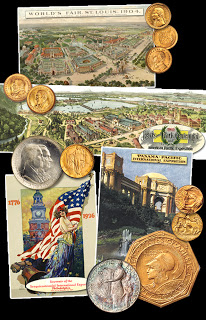
Following the 1900 Lafayette silver dollar, the next commemorative coins were produced in connection with the Louisiana Purchase Exposition held in St. Louis in 1904. These were commemorative gold dollars, each dated 1903 (the actual hundredth anniversary year of the Louisiana Purchase). One featured the portrait of Thomas Jefferson, who was the architect of the deal acquiring the land in 1803. The other showed President William McKinley, who had been assassinated in September 1901. Why McKinley was chosen is not particularly clear, except that the subject was probably thought to aid in the sale of the coins. To no avail. Although 250,000 coins were struck, amounting to 125,000 of each variety, only about 17,500 found buyers. An overabundance of promotion and hyperbole by entrepreneur and numismatist Farran Zerbe simply turned a lot of people off.
The St. Louis World’s Fair was a great success. Attractions ranged from the Ferris Wheel (relocated from Chicago) to the curious Hale’s Tours featuring trips through the Alps and elsewhere. The Mills Novelty Company of Chicago set up a penny arcade with all sorts of wonders available for anyone with a pocket full of coins. The Inside Inn, a hotel on the fair grounds, was popular. A hold-to-light postcard (look at it with a lamp in the background, and the windows in the building become illuminated) proved to be a key item for postcard enthusiasts. Do-it-yourself photography and automobiles, current nationwide fads, were popular aspects as well.
The Lewis and Clark Exposition
Next on the list of world’s fair commemorative coins are the 1904 and 1905 gold dollars made for the Lewis and Clark Exposition held in Portland in 1905. The mintage was just 10,000 each. This event attracted worldwide exhibits, but was small in comparison to the St. Louis and Chicago extravaganzas. Relatively few gold dollars were sold, as by that time the Louisiana Purchase gold dollars, which had been marketed by Zerbe at $3 each, had laid an egg and were available from coin dealers for less than the issue price.
An effort was made by Zerbe to have commemoratives struck for the 1907 Jamestown (Virginia) Tercentenary. This did not happen, although various medals were issued.
The Panama-Pacific International Exposition
In 1915 the Panama-Pacific International Exposition opened in San Francisco, a grand affair and worthy companion to the Columbian and Louisiana Purchase events. Art, science, history, technology, and other elements of society were showcased to fine advantage. For this world’s fair Farran Zerbe hit a home run, convincing the powers that be to offer a grand collection of five different commemorative coins. These included a half dollar, gold dollar, quarter eagle, and two varieties of $50 gold pieces. Again, sales estimates were overly optimistic, and many were melted. However, today the coins are highly prized and are numismatic favorites. The 1915-S gold $50 of round format, of which 1,500 were minted but only 483 were sold, stands today as the rarest of all commemoratives.
The Sesquicentennial Exposition
The final entry on the list of American world’s fairs that furnished a venue for commemorative coins is the 1926 Sesquicentennial Exposition held in Philadelphia in 1926, marking the 150th anniversary of the Declaration of Independence. For this event commemorative half dollars and quarter eagles were produced in large quantities. The designs were viewed as rather insipid, and sales were slow. In fact, even though the event was staged in the so-called Roaring Twenties, and money was everywhere, the event was not particularly popular, and many exhibitors registered losses, including displays of elegant automobiles for sale and a set-up by the J.P. Seeburg Piano Company showcasing its top-of-the-line Style H Solo Orchestrion.
Thus, the curtain came down on commemorative coins issued for American world’s fairs.
To be sure, the Century of Progress Exposition in Chicago in 1933 (where the 1933-D Oregon Trail half dollar was specifically sold, but this is a technical point), the World’s Fair in New York in 1939, another in 1964, and other world’s fairs took place (in Knoxville, for example) but none were featured on commemorative coins.
What might have been but wasn’t took place, or didn’t take place, in the early 1970s. It was thought that 1976 would be a grand opportunity for a world’s fair in Philadelphia to celebrate the nation’s Bicentennial. A lot of discussion was held, but then politics reared its ugly head, and some said the money would better be used for welfare or other purposes, discussions deteriorated, and nothing ever happened—by all accounts a great opportunity missed by Philadelphia as well as all of America. Today in 2008 I am not aware of any serious discussions of another world’s fair to be held in America.
Today a complete collection of silver commemorative coins relating to these world fairs in the United States is quite affordable and consists of an 1893 Isabella quarter plus 1892 and 1893 Columbian half dollars, a 1915-S Panama-Pacific half dollar, and a 1926 Sesquicentennial half dollar. The gold coins are considerably more expensive, particularly the Panama-Pacific $50 pieces, and consist of two varieties of 1903 gold dollars, the 1915-S gold dollar, quarter eagle, and two styles of $50, and the 1926 Sesquicentennial quarter eagle.





